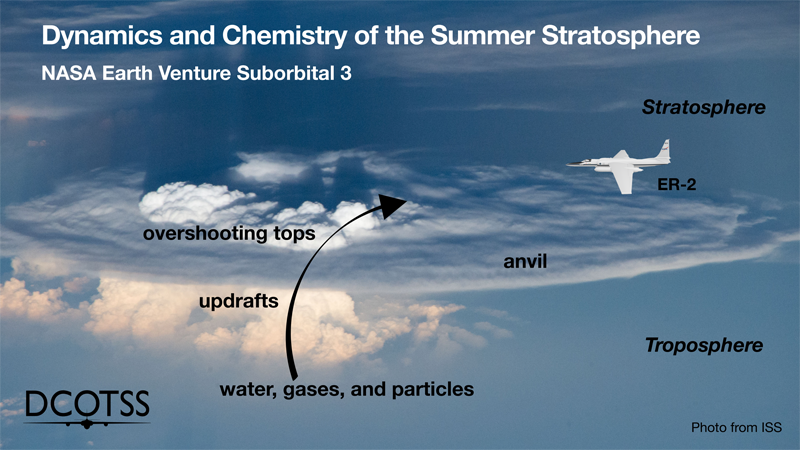
By LESLIE EIKLEBERRY
Salina Post
An airplane of a different kind, the NASA kind to be specific, has been using the Salina Regional Airport the past couple of weeks while on a scientific mission.
University and NASA scientists are studying the intense summer thunderstorms over the central United States to learn how they affect the Earth's stratosphere and how those effects contribute to climate change.
The Dynamics and Chemistry of the Summer Stratosphere (DCOTSS) airborne science mission began flying out of the Salina Regional Airport earier this month. The mission will continue to fly from Salina Regional this summer and is scheduled to do so in the summer of 2022 as well.
Several of the scientists involved in the project participated in an online media briefing Tuesday.
Kenneth Jucks, program manager for NASA’s Upper Atmosphere Research Program, participated in the briefing from Chicago's O'Hare International Airport while on his way to Salina.
Jucks explained that while NASA does the majority of its scientific investigations with space-based data, the agency also deploys aircraft in its quest for knowledge.
Jucks said that NASA solicits proposals from all areas of earth science for projects that could provide important information and this time NASA selected a proposal from Kenneth Bowman and his team to study the effects of intense thunderstorms on the Earth's atmosphere.
"They put together a very compelling program. It reviewed extremely well, and we're excited to go and do it. As you can tell, I'm on my way to Kansas to go join the festivities right now. I'm excited to see what type of data they're collecting," he said.
Bowman, principal investigator for the mission a professor of atmospheric science at Texas A&M University, said the project team includes research groups from seven universities, four NASA centers, the National Center for Atmospheric Research, and the National Oceanic and Atmospheric Administration.
Bowman said that most thunderstorms occur in the lowest layer of the atmosphere, the troposphere, however, with the intense storms that the project is studying, the updrafts can overshoot the troposphere and blow into the next highest layer, the stratosphere.
"The stratosphere contains the Earth's ozone layer, which protects us from harmful solar ultraviolet radiation. That is 'UV,'" Bowman said. "We're interested in how these storms might affect ozone, among other things."
Bowman explained that much of the air that goes up in an updraft spreads out at the boundary of the troposphere and and stratosphere and forms the anvil of the storm.
"From the ground, you'll often see this characteristic anvil shape for a big thunderstorm. But at the tops of these updrafts, if they're strong enough, they actually overshoot into the stratosphere," he said.

Bowman said the air in the updrafts, if they are strong enough, can go from close to the ground up into the stratosphere in 20 to 30 minutes.
"These updrafts provide a very fast path for transporting water and pollutants into the stratosphere," he said. "The things that come out of the top include water and ice from the clouds, various gases, both natural and man-made gases, and particles, solid and liquid particles suspended in air that we call aerosols, and those are also of both natural and man-made origin."
Bowman said that over the last decade, scientists have learned that the intense, overshooting storms are more common than previously thought. The research project currently under way is the first such project to investigate how these strong storms affect the stratosphere.
The ER-2 research aircraft being used in the project is capable of operating at high altitudes above the anvil of a storm and will fly close to 70,000 feet high, Bowman said. In the summer, an anvil is typically approximately 45,000 high, he said. Additionally, flights thus far have lasted between five and eight hours.
"For DCOTSS, the ER-2 is carrying a payload of 12 state-of-the-art scientific instruments to measure meteorlogical parameters, gases, and particles that come out of the tops of these storms into the stratosphere," he said.
David Wilmouth, a scientist at Harvard University and the lead for Harvard’s Halogens instrument, said that the instruments on the aircraft are fully robotic.
"There's only one person on that plane. That's the pilot. He has to wear a pressure suit because the plane goes so high in the air," Wilmouth said. "So all the instruments are fully autonomous. They're preprogrammed to know what to do when they encounter different air in the stratosphere, and some of them are extremely sensitive."
Wilmouth emphasized the sensitivity of the instruments with this example, "The plane is flying along at potentially 100 degrees farenheit below zero and traveling at approximately 450 miles an hour and these instruments are making the measurements in real time. So it's a fantastic suite of instruments."
According to Bowman, the overshooting storms are quite common in the central United States, which is part of the reason the ER-2 is operating from the Salina Regiona Airport this summer and is scheduled to do so next summer as well.
"But also, they have a very good facility here. The airport is great. It's a great place to operate this airplane from. The runway is wide enough for the very long wings on the ER-2 and long enough," Bowman said.
Additionally, Salina Regional Airport has great hangar facilities "for both the aircraft and for all the scientists with lab and office space. This is really working out to be a great place to fly from," he added.
The ER-2 typically will fly two to three times per week, Bowman said.
"At this point, we have completed the first four science flights for this deployment and we're just beginning to analyze the exciting data that we have collected so far," Bowman said.






